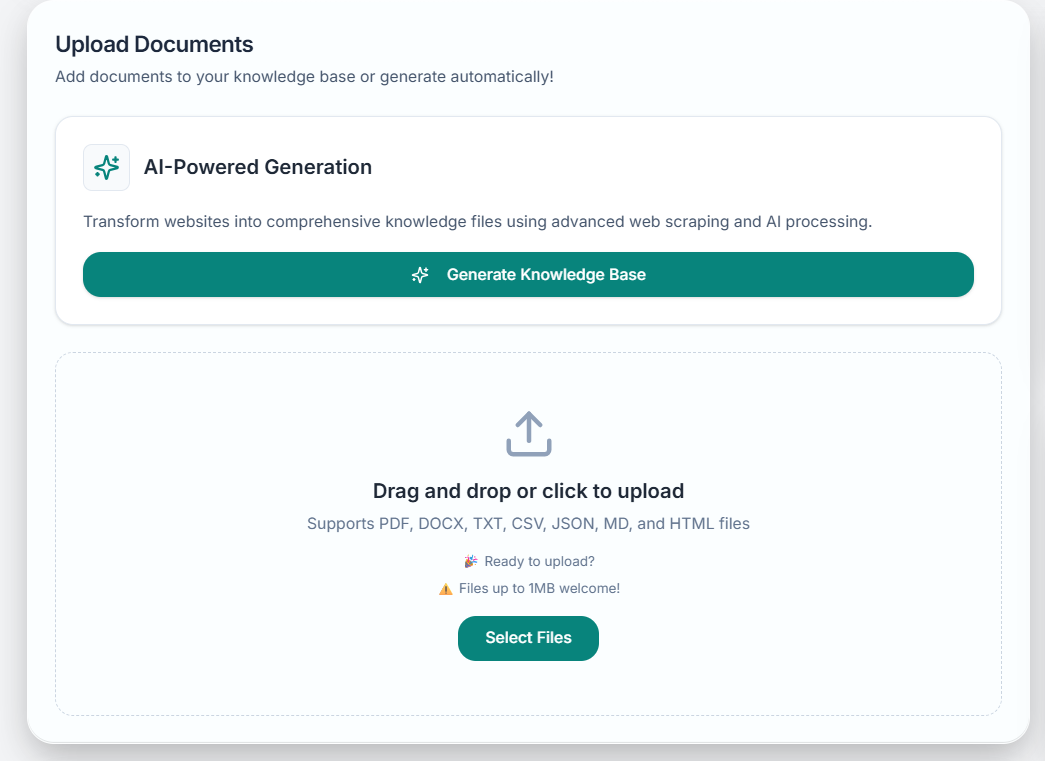Overview of Supported Formats
Ravvio’s knowledge base supports a comprehensive range of document formats to ensure maximum flexibility in training your AI agent with existing business content and documentation.
File Format Categories
Document Formats
PDF, DOCX, TXT, and MD files for comprehensive text-based content
Data Formats
CSV and JSON files for structured data and tabular information
Web Formats
HTML files for web content and formatted online documentation
Specialized Content
Markdown and structured text files for technical documentation
Detailed Format Support
PDF Documents
PDF Capabilities
PDF Capabilities
Supported Content Types:
- Product manuals and user guides
- Technical documentation and specifications
- Marketing brochures and sales materials
- Policy documents and procedures
- Financial reports and presentations
- Text extraction from standard PDF files
- Table and structured content recognition
- Preservation of document hierarchy and sections
- Header and footer identification
- Footnote and reference extraction
PDF Limitations
PDF Limitations
Current Restrictions:
- Image-based PDFs (scanned documents) require OCR preprocessing
- Password-protected PDFs need decryption before upload
- Complex layouts may affect text extraction accuracy
- Embedded multimedia content is not processed
- Use text-based PDFs when possible for best results
- Ensure PDFs are not password-protected
- Consider converting complex layouts to simpler formats
- Verify text extraction quality in processed results
Microsoft Word Documents (DOCX)
1
Content Recognition
Complete extraction of text, headings, and paragraph structure
2
Formatting Preservation
Maintenance of document hierarchy, bullet points, and numbered lists
3
Metadata Extraction
Capture of document properties, titles, and author information
4
Table Processing
Recognition and extraction of tabular data and structured information
DOCX Best Practices
Content Optimization
Recommended Structure:
- Use proper heading styles (H1, H2, H3)
- Maintain consistent formatting throughout
- Organize content with clear sections
- Include descriptive titles and headers
Quality Enhancement
Preparation Tips:
- Remove unnecessary formatting complexity
- Ensure text is readable and well-organized
- Use bullet points and numbered lists appropriately
- Include comprehensive content without excessive styling
Plain Text Files (TXT)
TXT File Benefits
TXT File Benefits
Advantages:
- Fastest processing and integration
- No formatting complications or extraction errors
- Universal compatibility across all systems
- Smallest file sizes for efficient storage
- Direct text content without conversion overhead
- FAQ documents and question-answer pairs
- Policy statements and procedure lists
- Product descriptions and feature lists
- Contact information and directory listings
- Simple documentation and reference materials
TXT Organization Tips
TXT Organization Tips
Structure Recommendations:
- Use clear section headers with consistent formatting
- Separate different topics with blank lines
- Include descriptive titles for each section
- Maintain consistent indentation for hierarchies
- Use asterisks or dashes for bullet points
- Keep paragraphs concise and focused
- Use consistent terminology throughout
- Include relevant keywords for better searchability
- Organize information logically from general to specific
CSV Files (Comma-Separated Values)
Data Structure
Supported Content:
- Product catalogs with specifications
- Pricing tables and rate sheets
- FAQ databases with questions and answers
- Contact directories and staff listings
- Inventory lists and availability data
Processing Features
CSV Capabilities:
- Header row recognition and column mapping
- Data type detection and validation
- Relationship identification between columns
- Automatic formatting for readable responses
CSV Optimization
1
Header Preparation
Use clear, descriptive column headers that indicate content type
2
Data Consistency
Ensure consistent data formatting within each column
3
Content Completeness
Fill in all relevant cells to avoid incomplete information
4
Logical Organization
Arrange columns in logical order from most to least important
JSON Files (JavaScript Object Notation)
JSON Structure Support
JSON Structure Support
Supported Structures:
- Nested object hierarchies for complex data
- Array structures for lists and collections
- Key-value pairs for configuration data
- Mixed data types within single files
- Hierarchical content organization
- Automatic structure recognition and parsing
- Preservation of data relationships and hierarchies
- Conversion to readable format for AI responses
- Integration with existing knowledge base content
JSON Best Practices
JSON Best Practices
Structure Guidelines:
- Use descriptive key names that indicate content purpose
- Maintain consistent naming conventions throughout
- Organize data logically with clear hierarchies
- Include all necessary fields for complete information
- Ensure valid JSON syntax and formatting
- Use appropriate data types for different content
- Include comprehensive data without unnecessary complexity
- Validate JSON structure before uploading
Markdown Files (MD)
Markdown Advantages
Benefits:
- Perfect for technical documentation
- Excellent formatting preservation
- Code block and syntax highlighting support
- Link and reference management
- Table and list structure recognition
Content Types
Ideal Applications:
- API documentation and developer guides
- Technical specifications and requirements
- User manuals with code examples
- README files and project documentation
- Knowledge base articles with formatting
Markdown Processing Features
1
Syntax Recognition
Complete support for standard Markdown syntax and formatting
2
Structure Preservation
Maintenance of headings, lists, tables, and code blocks
3
Link Processing
Recognition and preservation of internal and external links
4
Content Integration
Seamless integration with other knowledge base content
HTML Files
HTML Content Extraction
HTML Content Extraction
Supported Elements:
- Text content from paragraphs, headings, and lists
- Table data and structured information
- Link text and navigation elements
- Meta information and page titles
- Semantic content from HTML5 elements
- Automatic removal of navigation and promotional content
- Focus on main content areas and article text
- Preservation of content hierarchy and structure
- Conversion of HTML formatting to readable text
HTML Optimization
HTML Optimization
Preparation Recommendations:
- Clean HTML with minimal inline styling
- Semantic markup using appropriate HTML tags
- Clear content separation from navigation elements
- Descriptive page titles and meta information
- Focus on informational content over decorative elements
- Use proper heading hierarchy (h1, h2, h3)
- Include alt text for important images
- Maintain clean, readable HTML structure
File Size and Limitations
Size Restrictions
Individual File Limits
Maximum file size varies by format:
- PDF: 50MB maximum
- DOCX: 25MB maximum
- TXT: 10MB maximum
- CSV: 15MB maximum
- JSON: 10MB maximum
- MD: 5MB maximum
- HTML: 5MB maximum
Total Knowledge Base
Overall limitations:
- Total storage per account varies by plan
- Free accounts: 100MB total storage
- Paid accounts: 1GB+ total storage
- Enterprise: Custom storage allocations
Performance Considerations
Processing Speed Factors
Processing Speed Factors
File size impact:
- Larger files take longer to process and index
- Complex formatting increases processing time
- Multiple simultaneous uploads may affect speed
- Network speed influences upload and processing time
- Break large documents into smaller, focused files
- Remove unnecessary formatting and content
- Upload files during off-peak hours when possible
- Prioritize most important content for faster access
Quality vs. Quantity
Quality vs. Quantity
Best practices:
- Focus on high-quality, relevant content over volume
- Regular cleanup of outdated or redundant documents
- Strategic organization of content by importance
- Monitoring of knowledge base performance and usage
Upload Requirements and Recommendations
Technical Requirements
1
File Integrity
Ensure files are not corrupted and open properly in their native applications
2
Format Compliance
Verify files meet format standards and are not password-protected
3
Content Relevance
Confirm content is relevant to your business and customer interactions
4
Quality Assurance
Review content for accuracy, completeness, and current information
Naming Conventions
File Names
Best practices:
- Use descriptive names that indicate content
- Avoid special characters and spaces
- Include version numbers for updated documents
- Use consistent naming across related files
Organization
Structure tips:
- Group related documents logically
- Use prefixes for different content types
- Include dates for time-sensitive content
- Maintain clear categorization system
Content Preparation Guidelines
Pre-Upload Optimization
Content Review
Content Review
Quality checklist:
- Verify information accuracy and currency
- Remove outdated or irrelevant content
- Ensure completeness of important topics
- Check for consistency in terminology and style
- Focus on customer-facing information
- Include frequently asked questions and answers
- Prioritize product and service details
- Consider user journey and information needs
Format Optimization
Format Optimization
Document preparation:
- Clean up formatting inconsistencies
- Use standard fonts and readable text sizes
- Organize content with clear headings and structure
- Remove unnecessary graphics and decorative elements
- Add descriptive titles and section headers
- Include relevant keywords naturally
- Provide context for abbreviations and technical terms
- Ensure logical flow and organization
Testing and Validation
1
Upload Testing
Test upload process with a small sample of documents first
2
Processing Verification
Confirm documents process correctly without errors
3
Content Validation
Verify extracted content matches original document intent
4
Response Testing
Test AI agent responses using content from uploaded documents
File Format Support: While Ravvio supports these formats, optimal results depend on document quality, structure, and content organization. Well-formatted, clearly structured documents will provide better AI agent performance.
